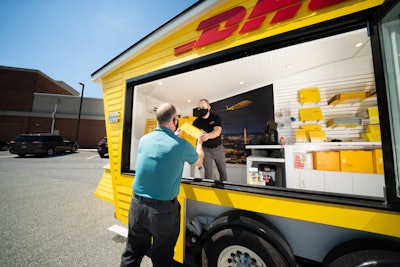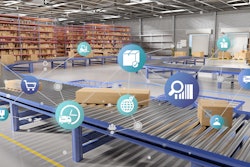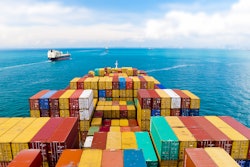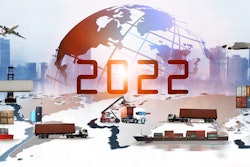
When 2021 hit, the world was ready for the New Year. Even if it brought with it a New Normal -- new way of doing business, a new way to shop for groceries and more -- the turning of the calendar meant putting a year of supply chain disruptions, restaurant closures and constant pivoting behind us.
But, then, on March 23, a stranded Evergreen container ship blocked navigation in Egypt’s Suez Canal, setting the stage for what would be a slew of supply chain disruptions after supply chain disruptions.
Suddenly, 2021 was quickly becoming a mirrored reflection of the year prior.
Then came the ransomware attacks, internet outages, container ships stuck at bay, bridge closures, driver shortages, ingredient shortages, natural disasters and more.
The hits just kept on hitting.
And, industry experts are already showing signs of struggle for 2022 into 2023, as routes to import/export remain clogged, ports continue to be backed up, cost of doing business increases and the labor shortage exists.
That’s because supply chains are messy. And, they’re only going to get worse before they get better.
In Food Logistics’ Nov/Dec 2021 issue, editor-in-chief Marina Mayer talks with several industry experts about the state of the supply chain and what’s in store for 2022.
Here’s an interview with Greg Foreman, VP operations, retail, DHL Supply Chain, who talks digitalization, warehouse automation and achieving end-to-end supply chain visibility, with excerpts publishing in Food Logistics’ Nov/Dec 2021 issue. [CLICK HERE to read the article in full].
Food Logistics: 2021 started off with supply chain disruption after supply chain disruption. From the Suez Canal blockage and natural disasters to ransomware attacks and an industry-wide labor shortage, the supply chain industry is having to prove its resiliency over and over again. Looking into 2022, what does the state of the supply chain look like?
Greg Foreman: Most experts agree that disruptions, shortages and stresses are here to stay for the immediate future, with many supply chains being stretched to the limits.
While we can’t change the tremendous increase in demand, as a global company, DHL Supply Chain is using its purchase power to help our customers as much as possible. We are hiring people. We want to be seen by our employees as a great place to work. And, that seems to be helping us to get more new employees on board than some of our competitors.
Post-COVID-19 companies will care even more about resilient supply chain operations. More than ever before, leveraging foresight and logistics innovation will be key for logistics professionals. Congestion in our ports is a present-day reality, so what we can do is leverage our own capabilities to the best extent and help customers get their products moving.
And, what we have heard in our customer meetings across many business sectors is that they really appreciate what we are doing for them. At this point, that’s really all they’re looking for in a partner; one that rolls up the sleeves and does its utmost to help them to keep their supply chains up and running to meet consumer demands.
Food Logistics: The cold food chain continues to face a host of risk/security challenges. What can companies be doing now to adapt for the future?
Foreman: Digitalization represents the next frontier in supply chain optimization. This digitalization in the supply chain is happening so fast and on so many fronts, it can be difficult for companies to keep pace. Disruptive technologies in the physical world – e.g., next-generation robotics and autonomous vehicles – are integrating with big data analytics, sensors, blockchain and other virtual applications. This integration is disrupting the traditional, linear supply chain model, and companies that successfully deploy supply chain digitalization stand to reap tremendous benefits.
The COVID-19 pandemic exposed a number of vulnerabilities with today’s supply chains, causing unexpected disruptions and shortages throughout different markets and industries. The experience highlighted an important fact that a number of supply chain managers already know: supply chain visibility and transparency is a must. DHL Supply Chain has invested in a number of digitalization tools to help improve our customers’ businesses.
In example is our MySuppyChain web-based platform that brings together data from various platforms across the supply chain to help cut through the clutter and highlight the data needed to reach objectives and achieve supply chain visibility. The platform allows customers to access track-and-trace data, inventory, operational performance and reporting, business analytics, customer service and more, providing end-to-end visibility of global supply chain operations.
As we move beyond the pandemic, more supply chain managers are beginning to understand that nothing short of end-to-end supply chain visibility—from the warehouse dock to the end destination—will provide the agility needed to deal with unforeseen risks and unexpected disruptions. Any hidden or blind spot within your supply chain hampers your ability to effectively react to unforeseen events and changing market conditions.
Food Logistics: In terms of transportation, what are some of the trends you’re seeing for 2022? How do emerging technologies like blockchain, Internet of Things, cloud-based, etc. play a role in the evolution of transportation in the cold food chain?
Foreman: While transportation management systems (TMS) provide the engine for digitalization, they often do not resolve all of transportation challenges. Complementary software packages and deep transportation expertise are required to achieve true real-time visibility and optimize capacity utilization.
Supply chain analytics and decision support tools have proven valuable in enabling site location decisions. While well established, these tools are continuing to advance in performance, primarily through the application of machine learning. They are also being augmented by new tools that enable use of much larger data sets to achieve levels of optimization not previously possible.
One of the areas where a standalone TMS system may fall short of expectations is in capacity optimization, particularly when managing dedicated or private fleets subject to empty return trips. A dedicated fleet management solution integrated with a TMS can reduce empty miles and identify opportunities for load consolidation from LTL to FTL at the same time. While adding a layer of complexity to transportation management, this approach can drive significant improvements in capacity utilization that more than offset the additional challenge of managing multiple platforms.
Food Logistics: Let’s talk supply chain visibility. What is your company – or what should companies – be doing to improve their own supply chain visibility?
Foreman: Achieving end-to-end supply chain visibility can often be a daunting endeavor for most companies to pursue on their own. It can be challenging to assess the current state and determine next steps or a roadmap for reaching the desired goal. It can also be time-consuming vetting visibility technologies and tools to find the right one.
Companies can either make the necessary investments or work with a third-party logistics (3PL) provider that has invested in visibility tools and digitalization to manage data flow. This will help enable the continued movement of products and provide the information needed for decisions about inventory placement and how to get product to consumers as quickly and efficiently as possible. This end-to-end visibility helps companies seamlessly integrate sourcing, manufacturing and packing operations to improve inventory management and control across their entire supply chain.
For instance, in our experience, achieving full visibility across transport is best accomplished by integrating a dedicated visibility solution with a TMS. These solutions, when properly executed, can eliminate blind spots in the transportation processes that can result from miscommunication at delivery docks or carrier transport data that doesn’t align with planned routes. However, it’s important to recognize that even these platforms don’t solve the visibility challenge unless integration with carriers is given adequate attention.
Food Logistics: The labor shortage is a real thing, and it’s impacting several facets of the supply chain. What is your company – or what should companies – be doing to hire, onboard and retain good quality supply chain workers?
Foreman: Demand for supply chain talent continues to be a serious challenge, with companies struggling to identify and attract qualified candidates. For most companies as they look to address capacity needs, it is more than simply meeting hiring quotas and headcount.
With access to a large enough labor pool, DHL Supply Chain can effectively and efficiently scale up or shift employees between locations and facilities to manage fluctuating needs. We’ve worked really hard to create more streamlined and efficient recruiting and onboarding processes that make it possible to match the right talent for the job and easily ramp up additional skilled workers for peak seasons and as demand increases.
DHL’s investment in technology that works seamless with our workforce in the warehouse creates a work environment that uses robotics for repetitive actions or transporting material from over distances in the warehouse. Our associates expect technology to be a part of their work life and appreciate benefits of reducing fatigue, lowering high overtime demands and learning to work with technology that improves their skills and value in the workplace.
DHL Supply Chain is also using data analytics to help improve resource planning to ensure the skilled labor needed. One of the ways we are doing this is by focusing on data that can help bring a greater understanding of the attributes associated with employee turnover. For many of our customers, we estimate that the cost of turnover per associate can be as high as $4,000. We analyze a variety of public and private data points to understand what is causing the turnover at a micro and macro level. This understanding enables us to recommend strategic changes at a high level and even run varying scenarios to discern which changes might be most effective.
Food Logistics: What are some things not addressed above that may be pertinent to our readers?
Foreman: As the supply chain continues to become more sophisticated and digitalized, data analytics is evolving into a powerful tool helping companies achieve greater supply chain visibility, flexibility and resiliency.
The challenge many companies have is adequately identifying, prioritizing and acting on the data to deliver measurable, obtainable business goals and value, and ultimately, predictive insight. Most are barely scratching the surface when it comes to the business value that can be achieved through establishing data analytics processes. Whether they are tracking the wrong data, or they do not have enough data or the right expertise to effectively analyze the data, many companies are missing vital opportunities to harness the power of data to solve their complex supply chain challenges.
Gathering data is just the first step in the data analytics journey. The real value of the data can only be properly unleashed and realized when it is analyzed and acted upon. The data might expose an issue or point to an opportunity, but only expert analysis can determine how best to address the issues or take advantage of the opportunities.
What is needed is an integrated analytics processes encompassing all aspects of the supply chain that can help diagnose operational issues, optimize network planning, generate efficiencies and predict future scenarios to provide competitive advantage.
[CLICK HERE to read the article in full].




















